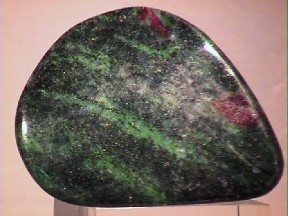|
Major Rock Types
|
A Rock, by a simple definition, is a solid with more than one component of a mineral or mineraloid. A single crystal is not a rock; but two crystals that are joined together, even if they are the same mineral, are technically a rock. The minerals or mineraloids may be large enough to be easily identified (such as in a pegmatitic granite), barely distinctive grains (as in a schist), or in a mixture of microscopic grains such as in a slate. A rock does not even need to have crystals but may be in the form of a non-crystalline solid state or glass, an amorphous mixture in which the chemicals are not crystallized into minerals, such as in obsidian. Generally rocks are considered to only be natural objects, but sometimes man-made substances are included as rocks.
There are well-known rocks on Earth that don't fit into these classifications: primordial rocks, represented by meteorites. These condensed in the vacuum of space from the same solar nebula as the Sun and planets.
Understanding rocks, their origins and classifications, is important
to understanding the minerals that are found in them,
found on them or are a part of them. Below are the major
types of rocks:
IGNEOUS - Rocks formed from melted rock or magma
- PLUTONIC - Intrusive:
- ANORTHOSITE
- CARBONATITE
- DIORITE
- DUNITE
- GABBRO
- GRANITE
- KIMBERLITE
- LAMPROPHYRES
- MONZONITE
- PEGMATITE
- PERIDOTITE
- PYROXENITE
- SYENITE
- TONOLITE
- VOLCANIC - Extrusive:
SEDIMENTARY - Rocks formed from the consolidation of sediments
- BIOCHEMICAL SEDIMENTARY ROCKS:
- BANDED IRON FORMATION (BIF)
- COAL
- BITUMINOUS
- ANTHRACITE
- LIGNITE
- JET
- PEAT
- CHALK
- CHERT OR FLINT
- COQUINA
- LIMESTONE
- PHOSPHORITE
- CLASTIC SEDIMENTARY ROCKS:
- EVAPORATIVE SEDIMENTARY ROCKS:
METAMORPHIC - Rocks formed from heat and pressure
UNCONSOLIDATED SEDIMENTS
In addition to the hard things called "rocks", minerals are sometimes found in loose collections of material called "unconsolidated sediments". Here are some major categories of these sediments, plus a couple of special interest to mineral collectors:
PRIMORDIAL ROCKS
Before the Earth was formed, before igneous or sedimentary or metamorphic was even possible, there were rocks and minerals. In the early solar system they condensed directly from the solar nebula, and are visible today as asteroids and comets in space, and as meteorites on Earth. :



